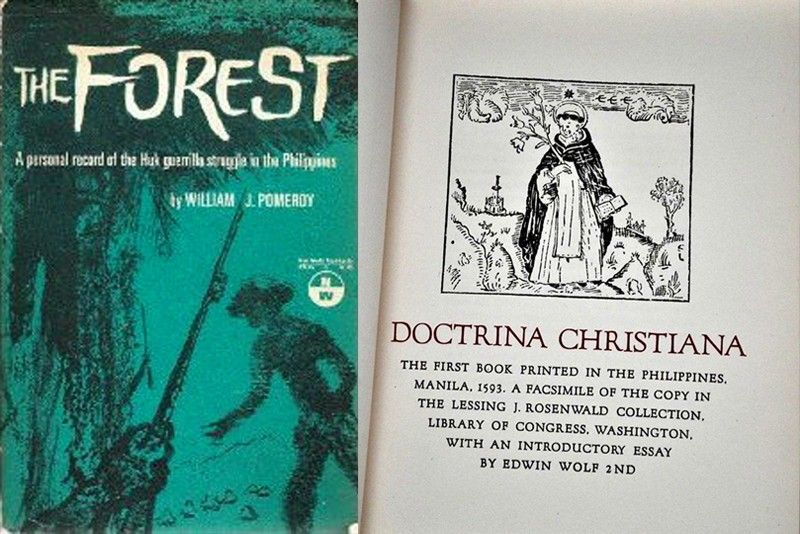Books with back stories

As I’ve been chronicling here these past few months, my fascination late in life with antiquarian books and documents has led me to some wonderful, intriguing, and often serendipitous discoveries. And as I’ve been saying, I’m a scavenger, not a scholar, so I will just as likely come across and even pick up junk as I will, now and then, a jewel. My most recent acquisitions have included a gorgeous Atlas de Filipinas from 1900 in very fine condition, early editions of the Noli and Fili published in Spain, a booklet of original sketches by one of the illustrators of Puck magazine from 1889, an illustrated travel book on Luzon and Palawan from 1887 by Alfred Marche, and a signed first edition of a book by one of my most admired authors, John Updike.
As much as possible, I seek out books that have some connection to the Philippines and its history and culture. If possible — and when I can afford it — I choose the first or earlier editions, signed by the authors, to establish some personal connection to the work at its very origins. It’s a fancy fetish, for sure, more than anything; you can often legally download the entire text for free online, and gain as much scholarship from that file. But there’s nothing like holding a book that the author himself or herself held and even scribbled his or her name on with a fountain pen (or a quill pen, in the case of my 300-year-old volumes with marginal notations in fine sepia ink). It returns you to how personal the act of writing and publishing can be, in this age of e-books and PDFs.
A few weeks ago, for example, I jumped on a book that turned up in Texas, a 1948 facsimile copy of the 1593 Doctrina Christiana, the very first book printed in the Philippines (a personal encounter with which I reported on here four years ago, at the Library of Congress in Washington, DC). Facsimiles are interesting but generally passed over by collectors — you can still get a facsimile of the Doctrina locally for P250 — but this one had a very special value. Not only was it published by the LOC very soon after the book (the only copy known to exist) resurfaced in Paris after the war and was donated to the LOC, proof that the LOC knew exactly how rare it was; but this copy was inscribed in green ink by Lessing J. Rosenwald to George L. McKay. Rosenwald happened to be the book collector who acquired the Doctrina and donated it, along with many other rarities, to the LOC; McKay was another well-known bibliophile. So this copy shows — against a suggestion I’d heard that Rosenwald didn’t know what he was buying — that Rosenwald prized the Doctrina highly enough to gift its facsimile to his collector-friends.

Rosenwald’s inscription.
That Doctrina facsimile has joined my collection, but another outstanding book didn’t, just when I thought it would. I’d won the bidding for a first edition, with dust jacket, of William Pomeroy’s The Forest (International Publishers, 1963). This is the book that, whenever I’m asked “Which book has influenced you the most?”, I give as an answer. It was my reading back in high school of this American GI-turned-Communist guerrilla’s lyrical and moving account of his time with the Huks in the mountains of Luzon that inflamed me to join the nationalist movement. Pomeroy met and married the Filipina Celia Mariano; they were captured, imprisoned, and later led a long life of exile in the UK, where they died not too long ago in their 90s. I already had a first edition of The Forest, but this copy was inscribed by Pomeroy to their friends Bill and Ranjana Ash — another storied couple, dedicated Marxists whose lives are well worth Googling. Sadly I later got a note from the seller that he could no longer find the book in his shop, and refunded me. What a loss!
Sometimes I don’t buy the book, but take note of some very interesting details about it. For example, I came across a work on Philippine fisheries, “Bangos Culture in the Philippine Islands,” taken from an April 1929 issue of the Philippine Journal of Science. It was co-authored by Albert W. Herre and Jose Mendoza, two pioneers in the field. But the bookseller noted that “This copy is unique in that the primary author, Albert W. Herre, has crossed out the name of the second author, Jose Mendoza on the credit line of the first page, and written alongside it, ‘This name (Jose Mendoza) was added and my paper altered after I had sent it in for publication, all without my knowledge. Herre.’ On the second page, Mr. Herre has crossed out the second paragraph (‘Description of the Bangos’) with a few pen lines (it is still very legible) and written alongside, ‘Added without my knowledge or consent. Herre.’… given that the primary author made the aforementioned annotations, it appears that he donated it to Harvard (and wanted to make sure that Harvard understood that he was the real and only author).” Are we looking at an example of professional jealousy in the sciences?
More on these discoveries next week.
* * *
Email me at jose@dalisay.ph. and visit my blog at www.penmanila.ph.



















